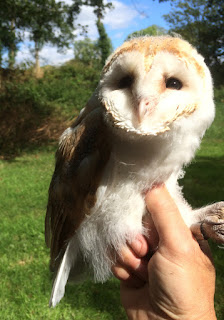With numerous Barn Owl nest boxes now in place at carefully selected sites throughout Duhallow, their value has been shown this summer with several boxes newly occupied by the owls.
The barn below had one of the first nest boxes to be installed in Duhallow, back in 2014. However, despite checking it each year, there was no sign of any Barn Owls moving in. Until this summer. When checked in August, there were three young Barn Owl chicks inside.
Three young barn owls in a newly occupied nest box, near Ballydesmond, August 2018.
Across Ireland, there are nest boxes which have been in place for many years before owls have moved in. In one case, in Kerry, it was eight years before the nest box was occupied, in Tipperary one was in place for almost 15 years before the owls finally decided to take up residence.
The fastest any box has been occupied was at another site in South Kerry when the box was installed in early April and the birds moved in and laid eggs just 3-4 weeks later. That is rare of course and it is more typically 2 to 4 years before boxes are used. Even in seemingly perfect sites some boxes have never been used though, as we have found out, it pays to remain optimistic!
Newly installed outdoor-type Barn Owl nest box, north Duhallow.
Most nest boxes are of an indoor type, placed in a disused barn or derelict building. Some are outdoor-type boxes, such as this one (above) in the north of Duhallow. Most of these are placed in trees, where suitable buildings are not present.
Barn Owl chick, east Duhallow, August 2018.
And the rewards of course are great. Barn Owls are one of the most beautiful of birds.
Barn Owl chick, near Ballydesmond, August 2018.
Overall, where the number of chicks was accurately known at individual nests, there was an average of 3.14 chicks per nest in Duhallow, well above the national yearly average of 2.2, so it has been a good year for the species here.
In total, 22 chicks were found, and 12 of these were ringed, so if we encounter those birds again we will have a good history of each.
Two young Barn Owls, near Dernagree, August 2018.
The above Barn Owl chicks were the latest in terms of timing. While most other nests were finishing up and the chicks fledging, this newly occupied nest box in an old barn has four chicks which have at least another month to go. Hopefully the autumn weather will be kind to them as they won't be flying for another five weeks or so, well into September.
Single Barn Owl chick in roof space, near Dromina, August 2018.
Although many of our nest sites are now in safe nest boxes, there are still those in more traditional sites, old buildings and ruins. The one above has its nest in the gap between a corrugated iron roof and the old thatched roof of a derelict cottage, a perfectly secure nest site, though pretty warm in the sun!
Fledged Barn Owl near Mallow, August 2018.
The bird above was one of three chicks which fledged from another newly occupied nest box. All three were old enough to fly well, though they were still hanging about the nest box, hoping to be fed by the parents when they return after dark. Eventually they will have to fend for themselves and head out into the world to find a nest site and a mate of their own.
Destroyed Barn Owl nest box, near Kanturk, August 2018.
Although the nesting season is winding down, there is still work to be done. A few nest boxes such as the one above, have been destroyed by winter storms and will have to be replaced, and there are numerous potential new sites where nest boxes can be installed. The 2018 breeding season, more than ever, has shown that Barn Owls will readily take to well-placed and maintained nest boxes, and these sites, with the cooperation of the landowners, provide some of the safest and most productive nest sites for this beautiful bird.





















